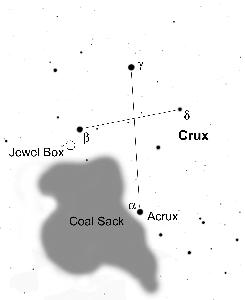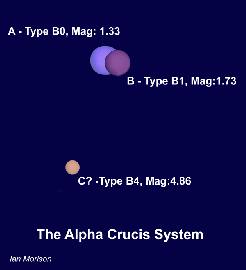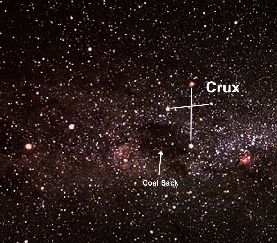Crux
This, perhaps the most well known of the southern constellations, is not quite as prominent as one might expect. Lying right along the plane of the milky way it tends to recede into the great mass of stars under dark skies. It is, however, easily found by following the line from the very bright stars Alpha through Beta Centauri which leads directly to Crux. It includes three A-List objects. However one, the Coal Sack, is actually a lack of anything to see so should it really be called an object?
Alpha Crucis - Acrux Double star E H
Alpha Crucis was too far south to have been given an ancient name so Acrux is simply a combination of the A in alpha and Crux. Being of first magnitude (0.83), it is the 12th brightest star in the sky and 321 light years distant from us. Under high power, a telescope reveals it to be a binary system with two very similar B type stars having magnitudes of 1.33 and 1.73 separated by 4 arc seconds. With surface temperatures of around 27,000K they are highly luminous, the brightest 25,000 time more luminous than our Sun. In fact, the brighter star is itself a double, the two component stars orbit each other every 76 days but are too close to split with a telescope. So Acrux is a triple star system. A further, type B4, star lies 90 arc seconds away and may belong to the system as well - it is labeled C? in the diagram. It has a similar proper motion - that is, its direction of motion through space - but is probably a more distant star that just happens to lie in the same direction.
Position: 12h 26.6m -63deg 06min
The Jewel Box Open Cluster B L
This is an open cluster, also called Kappa Crucis, that contains about 100 stars and is about 10 million years old. It lies some 7500 light years away and spans a 10 arc minutes field of view so filling a volume of space about 20 light years across. Lying close to Beta Crucis, it is easy to find and best seen with binoculars or a telescope at low power. It contains many highly luminous blue-white stars along with a central red supergiant that makes a beautiful colour contrast. It was named the Jewel box by Sir John Herschel who called it "a gorgeous piece of fancy jewellery".
Position: 12h 53.6m -60deg 18min
The Coal Sack Dark Nebula E B
Just to the south of the Jewel Box is a pear shaped region of obscuring nebula, 7 degrees long by 5 degrees wide. Called the Coal Sack, it is a dense region of dust and gas about 2000 light years away that is hiding the light from more distant stars. It is the most prominent and conspicuous dark nebula along the plane of the Milky Way and is easily picked out by eye as a big dark region against the bright band of light from the stars making up own galaxy. It will fill the field of view of all but the widest field binoculars.
Position: 12h 52m -63deg 18min







